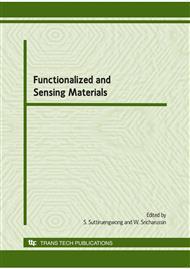[1]
D. I. Son, C. H. You, W. T. Kim, et al., Appl. Phys. Lett. Vol. 94 (2009), p.132103.
Google Scholar
[2]
K. S. Yook, S. O. Jeon, C. W. Joo, et al., Organic Electronics. Vol. 10 (2009), pp.48-52.
Google Scholar
[3]
J. Chen and D. Ma, J. Appl. Phys. Vol. 100 (2006), p.034512.
Google Scholar
[4]
G. Liu, Q. -D. Ling, E. -T. Kang, et al., J. Appl. Phys. Vol. 102 (2007), p.024502.
Google Scholar
[5]
V.S. Reddy, S. Karak, S.K. Ray, et al., Organic Electronics. Vol. 10 (2009), pp.138-144.
Google Scholar
[6]
L. Li, Q. -D. Ling, S. -L. Lim, et al., Organic Electronics. Vol. 8 (2007), pp.401-406.
Google Scholar
[7]
S. Pyo, L. Ma, J. He, et al., J. Appl. Phys. Vol. 98 (2005), p.054303.
Google Scholar
[8]
J. He, L. Ma, J. Wu, et al., J. Appl. Phys. Vol. 97 (2005), p.064507.
Google Scholar
[9]
S. J. Lee, J. -R. Koo, S. J. Kwon, et al., Microelectronic Engineering. Vol. 85 (2008), pp.2388-2392.
Google Scholar
[10]
J. H. Ham, D. H. Oh, S. H. Cho, et al., Appl. Phys. Lett. Vol. 94 (2009), p.112101.
Google Scholar
[11]
K.S. Yook, J. Y. Lee, S.H. Kim, et al., Appl. Phys. Lett. Vol. 92 (2008), p.223305.
Google Scholar
[12]
L. Ma, J. Liu, S. Pyo, et al., Appl. Phys. Lett. Vol. 80 (2002), p.362.
Google Scholar
[13]
Q. -D. Ling, D. -J. Liaw, C. Zhu, et al., Progress in Polymer Science. Vol. 33 (2008), pp.917-978.
Google Scholar
[14]
S.M. Sze, Kwok K. Ng, Physics of semiconductor devices, 3 rd ed. Hoboken, NJ: WileyInterScience (2007).
Google Scholar
[15]
K.L. Wang, B. Lai, M. Lu, et al., Thin Solid Films. Vol. 363 (2000), pp.17-181.
Google Scholar
[16]
Y. Xia, W. He, L. Chen, et al., Appl. Phys. Lett. Vol. 90 (2007), p.022907.
Google Scholar
[17]
L. Ma, S. Pyo, J. Ouyang, et al., Appl. Phys. Lett. Vol. 82 (2003), p.1419.
Google Scholar
[18]
V. S. Reddy, S. Karak, and A. Dhar, Appl. Phys. Lett. Vol. 94 (2009), p.173304.
Google Scholar
[19]
J. -G. Park, G. -S. Lee and K. -S. Chae, Journal of the Korean Physical Society. Vol. 48 (2006), No. 6, p.1505.
Google Scholar
[20]
L. P. Ma, J. Liu, and Y. Yang, Appl. Phys. Lett. Vol. 80 (2002), p.2997.
Google Scholar
[21]
F. Verbakel, S. C. J. Meskers, and R. A. J. Janssen, Appl. Phys. Lett. Vol. 91(2007), p.192103.
Google Scholar


